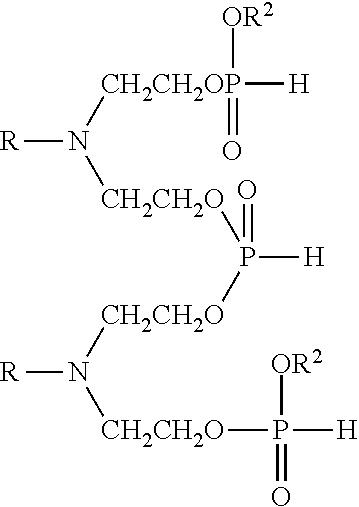Polymeric Phosphorus Esters for Lubricant Applications
a technology of phosphorus esters and phosphorus esters, which is applied in the direction of additives, lubricant compositions, petroleum industry, etc., can solve problems such as degradation of seal materials, and achieve the effect of improving seal and/or wear performan
- Summary
- Abstract
- Description
- Claims
- Application Information
AI Technical Summary
Benefits of technology
Problems solved by technology
Method used
Image
Examples
example 1
[0061]Synthesis of dialkylphosphite polymer from 1,6-hexane diol. A mixture of 1:1 mole ratio of 1,6-hexanediol and dimethyl phosphite is prepared and heated to 115-120° C. until removal of alcohol by distillation is complete (about 9 hours). The product contains 19.6 weight percent phosphorus and is a clear, colorless oil with a very mild odor.
example 2
[0062]Synthesis of trialkylphosphite polymer from 1,6-hexanediol. Substantially the same procedure is followed as for example 1 except that triethyl phosphite is employed as the phosphorus compound. The mole ratio of P:diol is 1.35:1 and the reaction temperature is 130° C. The product contains 15.7% phosphorus. (Similar reactions attempted at mole ratios of 1:1 and 1.25:1 lead to solid or gelled materials which are not further investigated.)
example 3-8
[0063]Synthesis of dialkylphosphite polymers from dimethyl phosphite and a variety of diols. Substantially the same procedure is followed as for examples 1-2. The P: diol ratio is 1:1.
ExDiolReaction temp, ° C.Reaction time, hr31,6-hexanediola115-120541,4-butanediol115-12025diethylene glycol120-1304.55adiethylene glycol12556triethylene glycol120-130571,6-hexanediol with120-1304.510 mol % tartaric acidb81,6-hexanediol with 3 mol120-1304% tartaric acidcaReaction mixture contains 0.4 mol % NaOMe as catalystbTartaric acid replaces 10 mole % of the dimethyl phosphite.cTartaric acid replaces 3 mole % of the dimethyl phosphite.
PUM
| Property | Measurement | Unit |
|---|---|---|
| weight percent | aaaaa | aaaaa |
| weight percent | aaaaa | aaaaa |
| lubricating viscosity | aaaaa | aaaaa |
Abstract
Description
Claims
Application Information
 Login to View More
Login to View More - R&D
- Intellectual Property
- Life Sciences
- Materials
- Tech Scout
- Unparalleled Data Quality
- Higher Quality Content
- 60% Fewer Hallucinations
Browse by: Latest US Patents, China's latest patents, Technical Efficacy Thesaurus, Application Domain, Technology Topic, Popular Technical Reports.
© 2025 PatSnap. All rights reserved.Legal|Privacy policy|Modern Slavery Act Transparency Statement|Sitemap|About US| Contact US: help@patsnap.com

